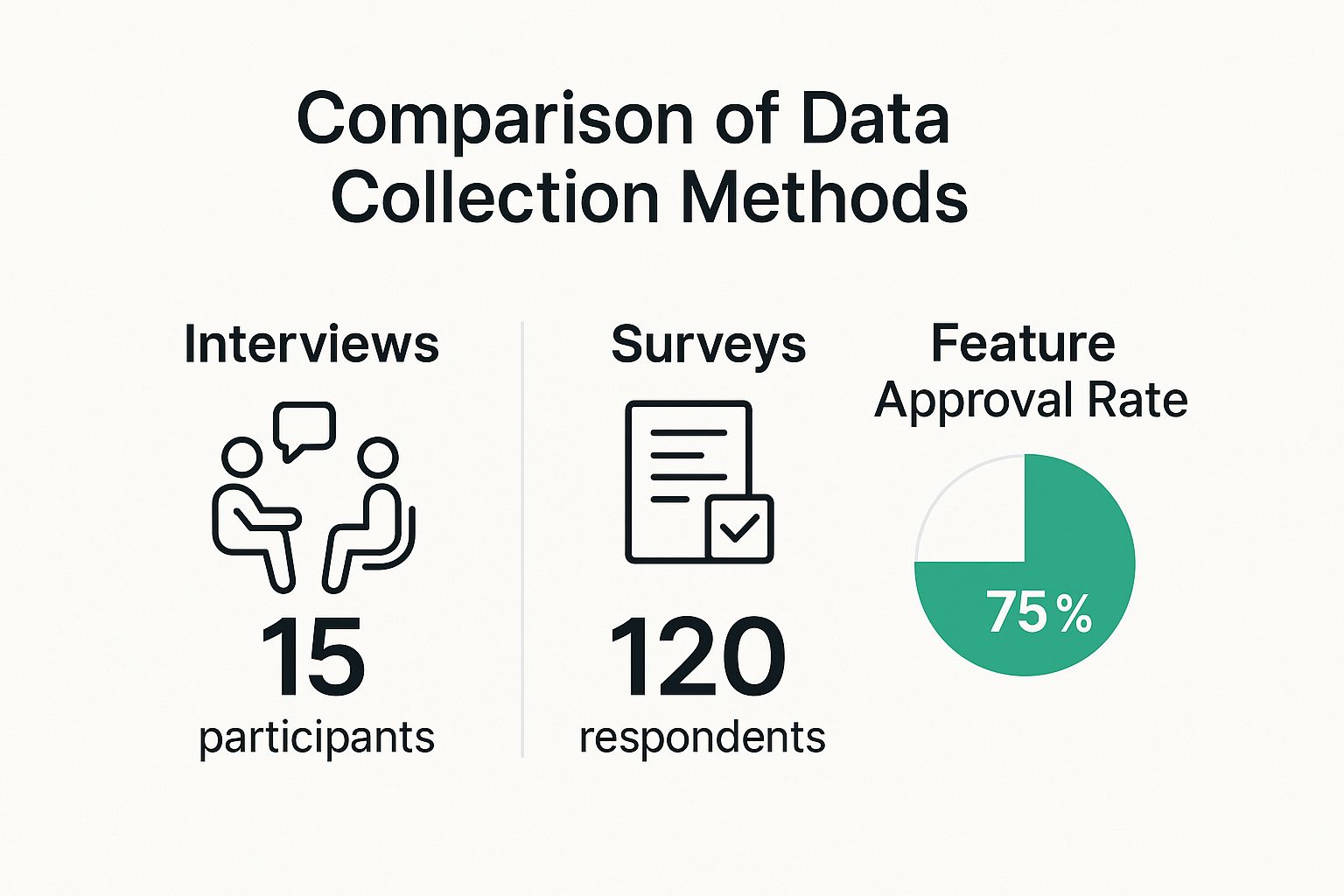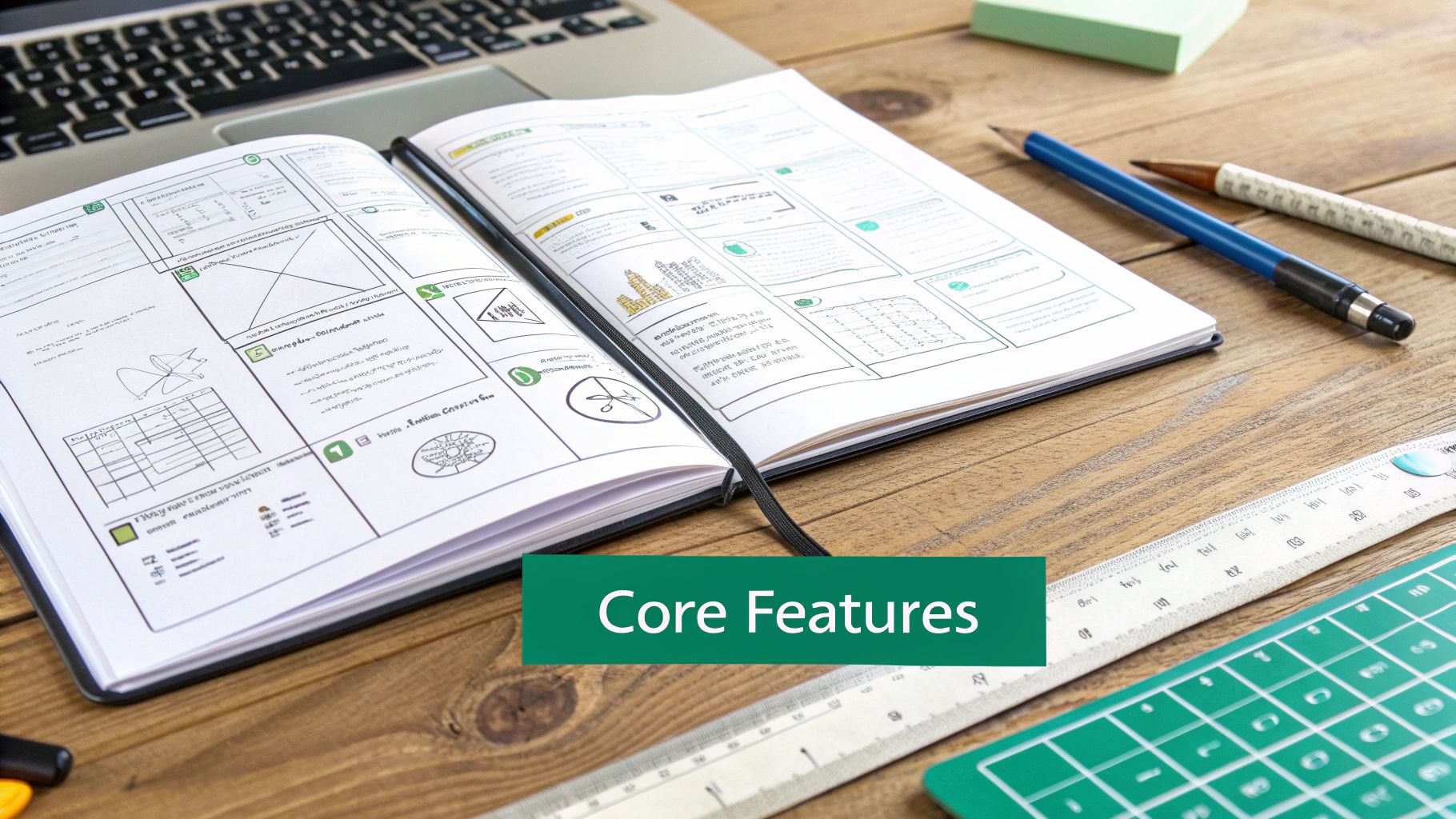Let's be honest, most founders get the idea of a Minimum Viable Product (MVP) wrong. They think it's about hacking together a buggy, half-baked version of their grand vision. But that's a surefire way to build something nobody wants.
An MVP isn't a product; it’s a process. It’s about launching the absolute simplest version of your idea to test one core assumption. It's a strategic tool for validated learning, designed to get you real answers with the least amount of effort and cash.
What Is a Minimum Viable Product Really?

Forget the idea that an MVP is your big product idea with half the features ripped out. That kind of thinking leads you down a long, expensive path, building in a bubble, only to discover the market doesn’t care when you finally launch. I've seen it happen too many times.
A true MVP is a continuous cycle. You identify your riskiest assumption, design the smallest possible experiment to test it, and let the results guide your next step. Think of it less like product development and more like a scientific method for your business.
The Shift From Product to Process
The whole point of an MVP is to maximize what you learn while minimizing your risk. Every startup idea is just a stack of unproven assumptions—about the customer, the problem, the solution, and the market. An MVP forces you to tackle the most critical one first.
For instance, your biggest risk probably isn't, "Can we build this feature?" It's more likely, "Will anyone even want this?" A proper MVP answers that second question before you've written a single line of code.
This mindset is non-negotiable for founders, especially when you're bootstrapping. It's what keeps you from burning through six months and your life savings on a beautiful product that solves a non-existent problem.
The True Purpose and Benefits
The goal here isn't just to launch something. It's to start a conversation with real, live users. For solo founders and small teams, this approach has some massive advantages:
- Market Validation: You get solid proof that people are willing to use (and eventually pay for) your solution before you go all-in.
- User-Centric Development: Feedback from actual users becomes the foundation of your roadmap from day one. This is how you build what people need, not just what you think they want.
- Resource Efficiency: By focusing on one core function, you slash development time and costs. It’s a sustainable way to build a business without a huge budget.
The real power of building a minimum viable product is that it changes your objective from "building a thing" to "testing a hypothesis." This shift is what separates successful startups from the ones that burn out building in the dark.
This concept isn't new. It has roots in industrial-era prototyping and was refined by lean manufacturing principles. Today, its value is well-established, with 65% of businesses using MVP feedback to guide their product development. If you want to dive deeper into the fundamentals, you can learn more about MVP and see how this iterative model helps startups avoid expensive mistakes by proving market demand first.
Finding a Problem Worth Solving
Let's get one thing straight: the foundation of a great business isn't a clever idea. It’s a painful, real-world problem. Before you even think about building a minimum viable product, you need to be absolutely certain you’ve found a problem people are desperate to solve. This means getting out of your own head and into the trenches of genuine customer discovery.
Too many founders fall in love with their solution before they truly understand the problem. The goal isn't just to get a few people to nod along; it's to gain unshakable confidence that a real market need exists.
Uncovering Deep-Seated Needs
Effective customer discovery starts with asking the right questions. You need to avoid leading questions that secretly pitch your idea, like, "Wouldn't it be great if you had an app that did X?" Instead, dig into their past behavior and current frustrations.
Focus on questions that encourage them to tell a story:
- "Tell me about the last time you tried to [accomplish a specific task]." This gets them to walk you through their process and the tools they're already using.
- "What was the most frustrating part of that experience?" This is where you find the gold—the exact pain points you could solve.
- "What have you tried to do to solve this? Have you paid for any solutions?" This reveals their motivation and, crucially, their willingness to pay.
The objective isn't to pitch your idea. It's to listen. Your goal is to become an expert on your customer's problem, not to sell them on your premature solution.
Running No-Code Validation Experiments
Once you've identified what seems to be a recurring pain point, it's time to test your core assumption with a simple experiment. And no, you don't need a product to do this.
A simple landing page is a classic, powerful validation tool. Describe the value your future product will offer and include a clear call-to-action, like an email signup for an early access list. Think about it: if people won't even give you their email address, they almost certainly won't give you their money later. This simple test can save you months of wasted effort.
Dropbox famously started this way. They launched a simple explainer video demonstrating their file-syncing concept before writing a single line of code. The video drove thousands of sign-ups overnight, proving people wanted the solution. For more inspiration, check out our guide on other powerful MVP examples that validated ideas with minimal resources.
This validation phase is your best defense against a common startup killer: premature scaling. CB Insights found that 29% of startup failures happen because they run out of cash, often by building too much, too soon. You can find more details on how MVPs fuel growth in this product development report.
By obsessing over the problem first, you're not just building a product; you're building a business on solid ground.
Defining Your Core Feature Set
Deciding what to build is often where the initial excitement of creating an MVP slams into a wall of indecision. It’s incredibly easy to get lost in a sea of “nice-to-have” features, but your first version demands ruthless focus. This isn't about building less for the sake of it; it's about building the right thing first to learn as quickly as possible.
You need a practical system to separate what’s truly essential from what’s just a shiny distraction. This process is all about creating a focused, achievable scope for your initial launch.
From Feature List to User Journey
Instead of starting with a massive, overwhelming list of every feature you can possibly imagine, try flipping your perspective. Think about the single most important job your user is trying to accomplish. What is the one critical path that takes them from their core problem to a genuinely valuable outcome?
Let's say you're building a simple project management tool for freelancers. Your brainstorming list might explode with ideas:
- Task creation
- Due dates
- Project folders
- Time tracking
- Client invoicing
- Team collaboration chat
Attempting to build all of that at once is a classic recipe for disaster. You'll spend months building and likely run out of steam or cash.
Instead, zero in on the core user journey. A freelancer needs to create a task, assign a due date, and mark it complete. That’s it. That’s the loop. This single, elegant path delivers immediate value and directly tests your core hypothesis: that freelancers need a simpler way to manage their work.
Prioritization With an Impact-Effort Matrix
Once you’ve locked down that core journey, you can start evaluating other potential features using an impact-effort matrix. It’s a simple but powerful tool that helps you visually sort which features give you the most bang for your buck.
Just plot each potential feature on a 2x2 grid. The vertical axis represents "Impact" (how much value it delivers to the user), and the horizontal axis is "Effort" (how long or difficult it is to build).
- High-Impact, Low-Effort: These are your quick wins. They should be at the very top of your MVP priority list.
- High-Impact, High-Effort: These are your big, juicy features. Plan to tackle these after your MVP has proven itself in the wild.
- Low-Impact, Low-Effort: Be careful here. These are tempting because they're easy, but they are the primary source of feature creep.
- Low-Impact, High-Effort: Avoid these like the plague. They are resource drains with almost no return.
This exercise forces an honest conversation with yourself (and your co-founder) about the true value and cost of each idea.
The goal of your MVP isn’t to offer every possible solution. It's to solve one specific problem so well that your first users become your biggest advocates, eagerly telling you what they need next.
All the data you gathered from your early validation—those interviews and surveys—feeds directly into this process.

When you see that 75% of your target users are asking for a specific feature, that's a massive signal. It tells you exactly where to place it on your matrix: it’s a high-impact item. This data-driven approach pulls you out of the world of guesswork and grounds your decisions in what real people actually want.
By focusing on a lean set of core features, you're not just building a product; you're building a powerful learning machine.
MVP Prioritization Framework Comparison
Choosing the right framework can make all the difference. While the Impact-Effort Matrix is a fantastic starting point, other methods might be a better fit depending on your specific situation.
Here's a quick comparison of some popular frameworks to help you decide.
| Framework |
Best For |
Key Benefit |
Potential Drawback |
| Impact-Effort Matrix |
Quick, visual prioritization for early-stage ideas. |
Simple to understand and immediately clarifies "quick wins." |
Can oversimplify complex features; "effort" can be hard to estimate. |
| MoSCoW Method |
Products with clear stakeholder requirements. |
Clearly categorizes features into Must-have, Should-have, Could-have, and Won't-have. |
Can lead to debates over what is truly a "must-have." |
| RICE Scoring |
Data-driven teams looking for objective prioritization. |
Uses a formula (Reach, Impact, Confidence, Effort) to create a quantifiable score. |
Requires reliable data, which can be scarce for a brand-new product. |
| Kano Model |
Understanding customer satisfaction and delight. |
Separates basic needs from "delighters" that create loyal users. |
More complex and requires significant user research to implement correctly. |
No single framework is perfect for every startup. The key is to pick one, apply it consistently, and use it to facilitate decisive action rather than endless debate. This structure will keep you moving forward and focused on shipping what matters most.
Choosing Your MVP Build Strategy

Okay, you've nailed down the core features. Now comes a decision that can make or break your startup before it even starts: how are you actually going to build this thing?
The right answer depends entirely on your situation—your technical skills, your budget, and how fast you need to move. There's no magic formula here, but knowing the trade-offs of each path is absolutely essential.
For founders who can't code, the explosion of powerful no-code platforms has been a total game-changer. Tools like Bubble or Webflow let you build surprisingly sophisticated apps with visual, drag-and-drop editors. This route gives you ultimate control and can be ridiculously cheap. The catch? You are the developer now, which means a steep learning curve and full responsibility for every bug, design flaw, and late-night fix.
Navigating Your Development Options
If spending weeks learning a new platform sounds like a nightmare, you'll need to bring in some outside help. This basically splits into two very different paths: hiring freelancers or finding a technical co-founder. Each choice will have a massive impact on your startup's trajectory.
Hiring freelance developers on platforms like Upwork or Toptal gives you immediate access to specialized talent. You can get your MVP built relatively fast, but it’s often the most expensive option up front. Expect the bill to run anywhere from a few thousand to tens of thousands of dollars, all depending on how complex your idea is.
A word of warning on freelancers: crystal-clear communication and a rock-solid scope of work are non-negotiable. Any misunderstanding can lead to expensive do-overs and brutal delays, burning through your cash when you can least afford it.
Looking for a technical co-founder is a completely different ballgame. This isn't just about hiring someone to write code; it's about finding a long-term partner. You're trading upfront cash for a slice of the company. An ideal partner doesn’t just bring coding chops—they bring a shared vision and a commitment to see it through. The problem? Finding that person can take months and demands a level of trust that’s almost like a marriage. This is exactly why a platform like IndieMerger, built to connect founders, can be so valuable.
Making the Right Choice for Your Vision
Your build strategy directly shapes your ability to learn and pivot. Getting this right is critical. To get a broader perspective, it’s worth exploring different MVP development strategies for startups and seeing how others have tackled this.
The core ideas behind an MVP—testing, learning, and refining—are universal. They apply far beyond the tech world. For instance, in Bhutan, this exact approach is used to validate new products for small-scale industries before they sink major investment, making sure what they build actually meets local needs. It's a powerful concept. You can read the full report on this application from the UN.
At the end of the day, your choice has to match your resources and your long-term goals. Pick the path that lets you learn the fastest.
For a deeper dive into the nitty-gritty, check out our guide on MVP development for startups.
Launching and Learning from Real Users
The moment your MVP is ready isn't the finish line—it's the starting pistol. But hold off on planning a massive public reveal. Big launches are for proven products. When you're building a minimum viable product, your only goal is focused, high-quality feedback, not widespread attention. A quiet, targeted release is your best friend here.
The first move is simple: get your MVP into the hands of that small, specific group of early adopters you found during your initial research. These are the people whose problems you set out to solve in the first place, and their insights are pure gold. Don’t just email them a link and cross your fingers; you need to be intentional.
Creating a Structured Feedback Loop
To make this phase actually count, you absolutely need a system for collecting and analyzing feedback. Without a clear structure, you'll drown in a sea of random opinions and conflicting advice. The real goal is to turn raw user reactions into a concrete, actionable to-do list for your next development sprint.
Start by setting up some simple, free analytics. A tool like Google Analytics or Mixpanel can show you what users are actually doing, which is often very different from what they say they're doing. Are they completing the core user journey? Where are they dropping off or getting stuck? This data gives you an unbiased look at user behavior.
Then, you need to combine this with qualitative feedback. This is where you find out the "why" behind the numbers.
- Direct Outreach: Personally email your early adopters. Keep it short, sweet, and ask for their honest thoughts. Make it incredibly easy for them to reply.
- Brief Surveys: Use a tool like Typeform or Google Forms to ask a handful of targeted questions about their experience. Don't make it a chore.
- User Interviews: This is a game-changer. Schedule 15-20 minute video calls with your most engaged users. Ask open-ended questions like, "Could you walk me through how you used it?" to uncover hidden pain points and unexpected moments of delight.
Your MVP launch isn't about getting a pat on the back. It's about finding out precisely where you were wrong, as quickly and cheaply as humanly possible. Embrace the criticism—it’s your roadmap to building something people actually want.
This approach transforms your development process from pure guesswork into a responsive, user-driven cycle.
From Feedback to Actionable Insights
Once feedback starts rolling in, your job is to get organized. A simple Trello board or even a spreadsheet is perfect for this. Create columns to categorize every piece of input: bug report, feature request, or general usability comment.
You’re looking for patterns. If five different users complain that the same button is confusing, that’s not an opinion; it's a high-priority fix.
This entire process is really just an extension of your initial research. You worked hard to find a problem worth solving, and now you’re working to validate your proposed solution. For a deeper dive on that critical first step, our guide on how to validate a business idea offers a practical framework.
By combining what users do (analytics) with what they say (interviews and surveys), you get the full picture. This balanced view is what gives you the confidence to decide what to build, fix, or even cut next, ensuring your product evolves based on real-world needs—not your own assumptions.
Common Questions About Building an MVP

Even with a solid plan, the MVP process can feel like a high-wire act. It’s natural to have questions. In my experience, most founders get tripped up by the same few worries, from protecting their big idea to dealing with the sting of early feedback.
Let's cut through the noise and tackle these common fears head-on.
One of the biggest anxieties I hear is, "What if someone steals my idea?" This fear can be paralyzing, stopping founders before they even start. And while I get it, the honest truth is that ideas are cheap.
Execution is what matters. Your real advantage isn't secrecy; it's your ability to learn and iterate faster than anyone else. By getting your MVP out there and gathering real-world data, you're already lapping anyone with a similar idea scribbled on a napkin. Speed wins, every time.
How Minimal Is Too Minimal?
The next big hurdle is defining "minimum." It's a classic Goldilocks problem. You need enough features to solve a core problem and prove your hypothesis, but not so many that you vanish for six months building a bloated product nobody asked for.
The secret is to focus on the Viable part, not just the Minimum. Your MVP absolutely must deliver real, tangible value to its first users. If it's so bare-bones that it's unusable or doesn't actually solve the problem, you won't get the feedback you need. You'll just get noise.
A great rule of thumb is to ask yourself: "Does this version create a complete, valuable experience for one specific user journey?" If the answer is no, you've probably cut too much. If you're adding features beyond that single core journey, you're probably building too much.
Think of your MVP as a satisfying slice of cake, not just a spoonful of flour. It has to be a complete, self-contained experience that leaves users understanding the value and wanting more. This way, you’re testing a solution, not just a random collection of features.
Handling Tough User Feedback
Then comes the moment of truth. You launch, and the feedback rolls in. Some of it will be brutal. It’s easy to get defensive or feel like your baby is ugly.
But here’s the reframe: negative feedback isn't an attack—it's a gift. It's a free, detailed map showing you exactly where to improve. Remember, the top reason startups fail (42% of them, in fact) is building something with "no market need." That harsh feedback is your best defense against becoming another statistic.
Here's a simple framework for processing criticism without losing your mind:
- Categorize it: Is this a bug, a confusing UI element, or a missing feature? Group similar feedback together.
- Look for patterns: One person's opinion is an anecdote. Five people complaining about the same thing is a signal.
- Ask "Why?": Don't just take feedback at face value. Dig deeper. Get on a quick call with the user to understand the root cause of their frustration.
Embracing this feedback loop is what turns a basic product into a thriving business. It’s the engine of the whole MVP process, turning early critiques into your greatest advantage.
Navigating these challenges is a lot easier with the right partner. At IndieMerger, we connect you with verified co-founders who have the complementary skills to help you build, launch, and grow. Find your co-founder on IndieMerger today.